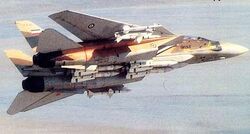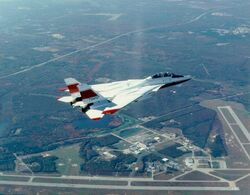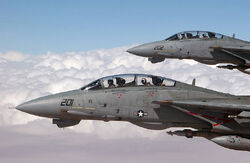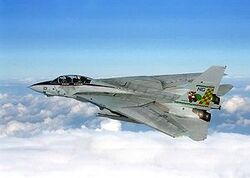Overview[]
The F-14 Tomcat is a supersonic, twin-engine, variable sweep wing, two-place fighter designed to attack and destroy enemy aircraft at night and in all weather conditions. The F-14 can track up to 24 targets simultaneously with its advanced weapons control system and attack six with Phoenix AIM-54A missiles while continuing to scan the airspace. Armament also includes a mix of other air intercept missiles, rockets and bombs.
The Tomcat is a 2-seat, twin-engine fighter with twin tails and variable-geometry wings. Its general arrangement consists of a long nacelle containing the large nose radar and 2 crew positions extending well forward and above the widely spaced engines. The engines are parallel to a central structure that flattens towards the tail; butterfly-shaped airbrakes are located between the fins on the upper and lower surfaces. Altogether, the fuselage forms more than half of the total aerodynamic lifting surface.
The wings are shoulder-mounted and are programmed for automatic sweep during flight, with a manual override provided. The twin, swept fin-and-rudder vertical surfaces are mounted on the engine housings and canted outward. The wing pivot carry- through structure crosses the central structure; the carry through is 22 ft (6.7 m) long and constructed from 33 electron welded parts machined from titanium; the pivots are located outboard of the engines. Normal sweep range is 20 to 68 deg with a 75-deg "oversweep" position provided for shipboard hangar stowage; sweep speed is 7.5 deg per second.
For roll control below 57 deg, the F-14 uses spoilers located along the upper wing near the trailing edge in conjunction with its all-moving, swept tailplanes, which are operated differentially; above 57-deg sweep, the tailplanes operate alone. For unswept, low-speed combat maneuvering, the outer 2 sections of trailing edge flaps can be deployed at 10 deg and the nearly full-span leading-edge slats are drooped to 8.5 deg. At speeds above Mach 1.0, glove vanes in the leading edge of the fixed portion of the wing extend to move the aerodynamic center forward and reduce loads on the tailplane.
The sharply raked, 2-dimensional 4-shock engine intakes have 2 variable-angle ramps, a bypass door in the intake roof, and a fixed ramp forward; exhaust nozzles are mechanically variable. Viewed from ahead, the top of the intakes are tilted toward the aircraft centerline; from above, the engines are canted outward slightly to reduce interference between intake airflow and the fuselage boundary layer. The engines exhaust through mechanically variable, convergent-divergent nozzles.
Following the loss of three aircraft over a four week period in 1996, the CNO ordered a safety stand down to review what was known in order to find out if there were any operational restrictions that needed to be placed on the aircraft. The Navy placed interim restrictions on the F-14 in the low altitude, high speed environment. Afterburner use was prohibited for F-14Bs and F-14Ds at all altitudes except for operational emergencies.
The Grumman F-14, the world's premier air defense fighter, was designed to replace the F-4 Phantom II fighter (phased out in 1986). F-14s provided air cover for the joint strike on Libyan terrorist targets in 1986. The F-14A was introduced in the mid-1970s. The upgraded F-14A+ version, with new General Electric F-110 engines, now widespread throughout the fleet, is more than a match for enemy fighters in close-in, air combat.
The AWG-9 is a pulse-Doppler, multi-mode radar with a designed capability to track 24 targets at the same time while simultaneously devising and executing fire control solutions for 6 targets. Designed in the 1960's and one of the oldest air-to-air radar systems, the AWG-9 is still the most powerful and new software will increase its capabilities for the 21st century.
The cockpit is fitted with a Kaiser AN/AVG-12 Head-Up Display (HUD) co-located with an AN/AVA-12 vertical situation display and a horizontal situation display. A Northrop AN/AXX-1 Television Camera Set (TCS) is used for visual target identification at long ranges. Mounted on a chin pod, the TCS is a high resolution closed circuit television system with two cockpit selectable Fields Of View (FOV), wide and narrow. The selected FOV is displayed in the cockpit and can be recorded by the Cockpit Television System. A new TCS, in development, will be installed in all three series aircraft. Electronic Support Measures (ESM) equipment include the Litton AN/ALR-45 radar warning and control system, the Magnavox AN/ALR-50 radar warning receiver, Tracor AN/ALE-29/-39 chaff/flare dispensers (fitted in the rear fuselage between the fins), and Sanders AN/ALQ-100 deception jamming pod.
The Tomcat has an internal 20-mm Vulcan Gatling-type gun fitted on the left side, and can carry Phoenix, Sparrow, and Sidewinder AAMs. Up to 6 Phoenix missiles can be carried on 4 fuselage stations between the engines and on 2 pylons fitted on the fixed portion of the wing; 2 Sidewinder AAM can be carried on the wing pylons above the Phoenix mount. Although the F-14 was tested with conventional "iron" bombs on its external hardpoints in the 1960s, the BRU-10 ejection racks were not strong enough to provide a clean separation. Tests in 1988-1990 showed that BRU-32 racks could drop Mk 80-series bombs safely. Later tests would qualify the AGM-88 HARM and the AGM-84 Harpoon.
Initial operational capability in 1973; first flight on 21 December 1970. 79 Tomcats were delivered to Iran before the 1979 Revolution. They are normally grounded for lack of parts; some were seen flying during December 1989 Iranian maneuvers. The US Navy has 699 in service or on order, with deliveries continuing. (The aircraft was not procured by the US Marine Corps.)
Since the early 1980s F-14s have had provision for the attachment of the Tactical Air Reconnaissance Pod System (TARPS), carrying optical and infrared cameras and permitting the aircraft to perform the photo reconnaissance role without degrading its performance in other roles. The only modifications required are wiring changes and cockpit readouts. In 1989, the Navy decided to phase out the F-14's reconnaissance mission in favor of using F/A-18 Hornets. During Operation Desert Storm in January-February 1991, however, F-14s flew 781 TARPS missions. In FY96, all active duty F-14 squadrons, except Fighter Squadron (VF)-154, were relocated to Naval Air Station (NAS) Oceana, Virginia. VF-154 will remain at NAS Atsugi, Japan, through FY03. The Reserve F-14A squadron, VF-201, was located at the Joint Reserve Base Fort Worth, Texas and transitioned to F/A-18 Aircraft in FY99. [1]
Thumb|right|250px|F-14 Tomcat explodes while breaking soundbarrier
Upgrades[]
The original design airframe life for the F-14 was 6,000 hours, but was later extended to 7,200 hours. The Navy intends to retire the F-14A force by 2003-4, F-14B by 2007, and the F-14D by 2008. While the F-14 continues to meet current operational commitments, the Navy has been working to improve those aircraft systems which are the highest readiness degraders; which include the radar transmitter, inertial navigation system, and radar antenna. The Navy made the decision not to upgrade the engines because they would be too expensive to put in an aircraft which would be removed from service a few years after being re-engined. Through extensive in-service engineering analysis, the Navy installed a low cost, but very effective means of alerting aircrew of impending catastrophic TF30 engine failure. This cockpit warning light alerts the aircrew to a sudden rise in engine breather pressure [an indication of impending engine failure] in time to reduce engine power and safely land the aircraft. This new system greatly increases aircrew awareness and further contribute to safe F-14A operations. The Navy decided to incorporate the GEC Marconi Digital Flight Control System (DFCS) into all F-14 aircraft to significantly improve flight safety. The system is designed to protect aviators against unrecoverable flat spins and carrier landing mishaps. DFCS also incorporates a lateral stick-to-rudder interconnect designed to improve less than desirable flying qualities in the powered approach configuration. Pilots agree that with the DFCS the Tomcat is more maneuverable and has crisp response to pilot control inputs. The new system should improve performance and safety during carrier landings. This modification affects 211 active duty and 16 reserve F-14 aircraft. The Foreign Comparative Test (FCT) demonstrated that DFCS drastically decreases the chance of entering out-of-control flight and improves the F-14's ability to recover, if a spin is entered. Departure from controlled flight has been a primary causal factor in 35 F-14 mishaps. Also significant is its ability to improve carrier approach line-up control addressing a problem often cited as a contributing factor in carrier landing mishaps. The incorporation of DFCS increases safety, both during "edge-of-the-envelope" maneuvering flight and carrier landings.
The new the Digital Flight Control System [DFCS] provides enhanced maneuverability for the F-14. The DFCS control panel replaces the current AFCS panel in the front cockpit, the analog system in use since the aircraft's inception. It contains the modified SAS switches, and also displays maintenance codes for system failures identified during IBIT and in flight. System (DFCS) that replaced. The DFCS system has lived up to its promise of enhanced controllability and performance in the high AOA regimes and in the landing configuration. However, the structural issue raised by the enhanced roll rates achievable with the DFCS is a potential factor affecting the crucial problem of F-14 fatigue life. During validation of the existing NATOPS rolling G envelope, the primary F-14 test asset sustained extensive structural damage to the starboard engine weekly doors and aft fixed cowl when certain structural limits were exceeded. As it turned out, the problem was not due to DFCS but was related to a NATOP’s operational envelope which had not been previously verified. This resulted in the fleet-wide rolling G restrictions from NAVAIR. The impact to the program is going to be felt in an initial envelope for DFCS with reduced rolling g above and beyond the cutbacks for AFCS roll SAS-on, simply because the Navy cannot support any further structural testing until the F-14 test aircraft is repaired. Data is still being analyzed and the restrictions haven’t been fully defined yet, but it was anticipated that the initial envelope would still include 6.5 g’s symmetric throughout for gross weights of 49.5K or less. For the clean configuration: 4 g’s rolling to 570 KCAS, 3 g rolling to 700, and 1 g rolls/no abrupt stick inputs above 700/1.4 For external tanks or Pylon mounted AIM-54s: the "region 3" from NATOPS will begin above 570 KCAS/1.15 TMN at low alt, or 500 KCAS above 25K. In late 1995 the F-14 Tomcat took on a new combat mission as part of Operation Deliberate Force in Bosnia. Nicknammed "Bombcat's", they delivered laser-guided bombs while other aircraft painted the targets with lasers. With the addition of the precision strike mission for F-14 aircrews, there was a shift in the emphasis of training; flight hours now have to be devoted to air-to-ground training as well as for air-to-air training.
Precision Strike provides the F-14 the capability to deliver laser-guided bombs for air-to-ground missions. It consists of the LANTIRN pod with laser designator and internal navigation system, LANTIRN control panel and night vision capable displays. In LANTIRN equipped F-14As and F-14Bs, the TID has been replaced with the PTID. In 1994 the Navy planned to spend over $2.5 billion to add limited ground attack capability and other improvements to 210 F-14 Tomcat fighter aircraft (53 F-14Ds, 81 F-14Bs, and 76 F-14As). The ground attack capabilities were required to partially compensate for the loss in combat capabilities during the period starting in 1997, when all of its A-6E Intruder attack aircraft were retired, to the turn of the century when the F/A-18E/F, the next generation strike fighter, was scheduled to arrive. The F-14 is undergoing two upgrades. [1]
F-14A Tomcat[]

F-14A Tomcat
The F-14A Aircraft is the basic platform of the F-14 series. It is equipped with two TF30-P-414A engines. Sixty "core" F-14A Aircraft are being upgraded with the AN/ALR-67 Countermeasure Warning and Control System, LANTIRN and the Programmable Tactical Information Display (PTID). In all F-14 series aircraft, the Automatic Flight Control System (AFCS) will be replaced by the Digital Flight Control System (DFCS). In the late 1970s the Defense Department experienced very substantial engine problems both with the F-14 with the TF-30 engine, and with the F-16 and the F-15 with F-100 engines. They were so serious that there was consideration given to developing new engines for the aircraft, which would have been an enormously difficult undertaking. It was decided instead to make upgrades and improvements in the engines. The engines in the later models of the F-14 are entirely adequate for the purpose. The engines in the F-14As have been improved so that they are also effective, although they are not the engine the Navy would have put in the airplane from the beginning if there had been a more powerful engine design then. In the mid-1990s one change that was made in the F-14 was the introduction of a Digital Flight Control System to the F-14 to prevent the pilot from making an unsafe or unauthorized maneuver, reducing the burden on the pilot to remember what cannot or should not be done under certain conditions. Funding for the new Digital Flight Control System -- about $80 million -- was obtained by reprogramming money in Fiscal 1996. The existing TARPS Pod System will be replaced with the TARPS Digital Imaging System. The Bol Chaff System will be added as part of an integrated modification program. The incorporation of these changes will not change the designation of the F-14A. [1]
F-14B Tomcat/Bombcat[]

F-14B Tomcat/Bombcat
The F-14B is either a remanufactured F-14A or new production aircraft, both equipped with F110-GE-400 engines, which replaced the TF30-P-414A engines. The F110-GE-400 is a new design which emphasizes reliability, maintainability, and operability. The new high technology engine improves capability and maneuverability without throttle restrictions or engine trimming. Sixty-seven F-14B Aircraft are being modified to extend the service life of the airframes and improve the offensive and defensive posture of the platform. This includes the F110-GE-400 engine, Fatigue Engine Monitoring System, AN/ALR-67 Countermeasure Warning and Control System, Gun Gas Purge Door Engineering Change Proposal (ECP), Direct Lift Control/Approach Power Compensator ECP, AN/AWG-15F ECP, and Engine Door Tension Fittings ECP. In addition, the AN/ASN-92 Carrier Aircraft Inertial Navigation System (CAINS) I will be replaced with the Embedded GPS Inertial (EGI) Navigation System. The F-14B Upgrade includes a MIL-STD-1553B Digital Multiplex Data Bus (DMDB), Programmable Multi-Display Indicator Group (PMDIG), PTID, the AN/AWG-15H Fire Control System, AN/ALR-67D(V)2 Radar Warning Receiver, EGI, and Mission Data Loader. Other survivability improvements were developed under the F-14 Airframe Change Number 828, Multi-Mission Capability Upgrade. The modified F-14B Aircraft is referred to as the F-14B Upgrade; modifications will be completed in FY01. [1]
F-14D Super Tomcat[]

F-14D Super Tomcat
The F-14D is either a remanufactured F-14A or new production aircraft, both equipped with F110-GE-400 engines, new radar, and new avionics systems. The F-14D provides controls and displays that increase aircrew effectiveness through automation and simplicity. Additionally, the F-14D provides changes to the radar, airframe, electronic countermeasures systems, Naval Flight Officer (NFO) armament control panel, pilot air combat maneuvering panel, and emergency jettison panel which enhance the offensive and defensive posture of the platform. The AN/APG 71 Radar replaces the AN/AWG-9 Radar used in the F-14A/B and has fewer Weapon Replaceable Assemblies (WRAs), thereby reducing both weight and space requirements. The functional expansion is achieved by replacement of AN/AWG-9 analog processing hardware with more flexible digital processing. Major changes were made in the following areas: Signal Processor, Data Processor, Digital Display, Central Processor, Receivers, and Antenna configuration. The Infrared Search and Track System (IRSTS) is a Navy developed system which provides long range detection in the long wave infrared spectrum of both subsonic and supersonic targets. The Air Force common Joint Tactical Information Distribution System (JTIDS) terminal, when installed and integrated, provides secure, jam resistant, high capacity digital data and voice information distribution, and accurate relative navigation capabilities. Production shifted to the F-14D in 1988, and Initial Operational Capability for the F-14D Aircraft was in FY92. The original program schedules envisioned the first D delivery in March 1990 with an all-D fleet achieved by 1998. Plans called for 127 new-production F-14D and modification of 400 F-14A and F-14A+ to D configurations. The revised defense budget submitted in April 1989 proposed cancelling the new-construction portion of the program, but Congress authorized 18 new F-14Ds for 1990 with the stipulation that these would be the last new aircraft authorized--a total of 37. The first F-14D was delivered in February 1990. The funding plans for remanufacturing F-14As into F-14D(R)s in the 1990-1994 period included 6 in 1990, 12 in 1991, 24 in 1992, 48 in 1993, and 60 in 1994; the schedule was later scaled back to 18 in 1992, 20 in 1993, and 24 aircraft in 1994 and 1995. Further defense spending cutbacks eliminated almost all procurement funding for 1991 and provided no money at all in 1992-1993. The final blow fell in mid-February 1991 when the Navy cancelled an already-funded $780 million contract for 12 remanufactured F-14, effectively ending further production. [1]
